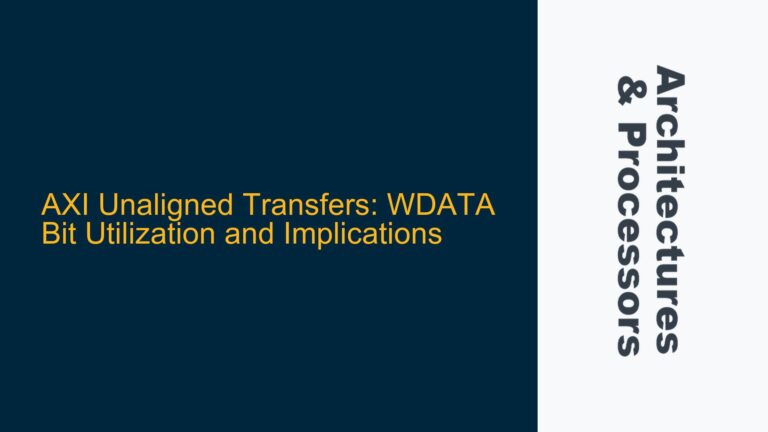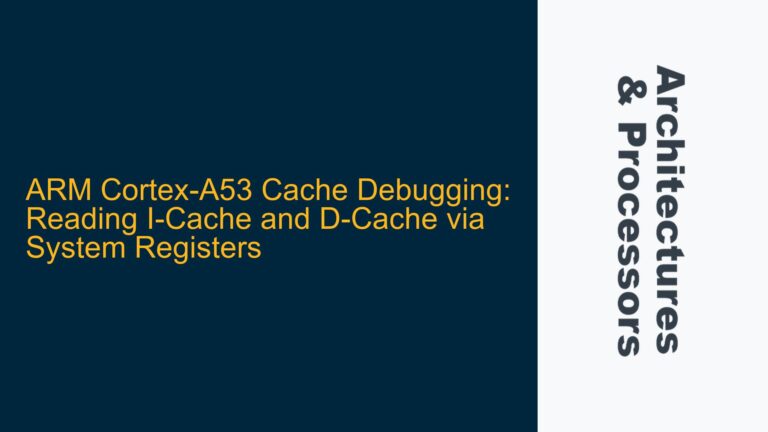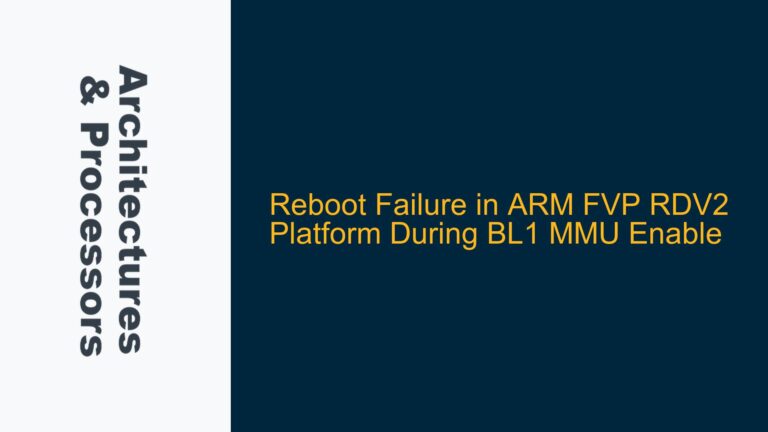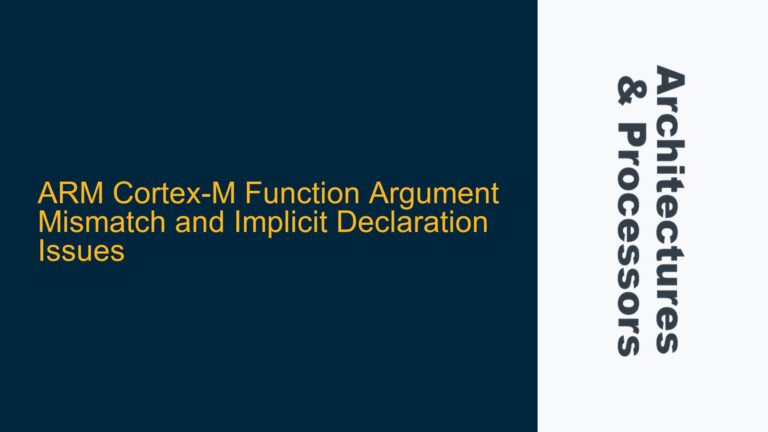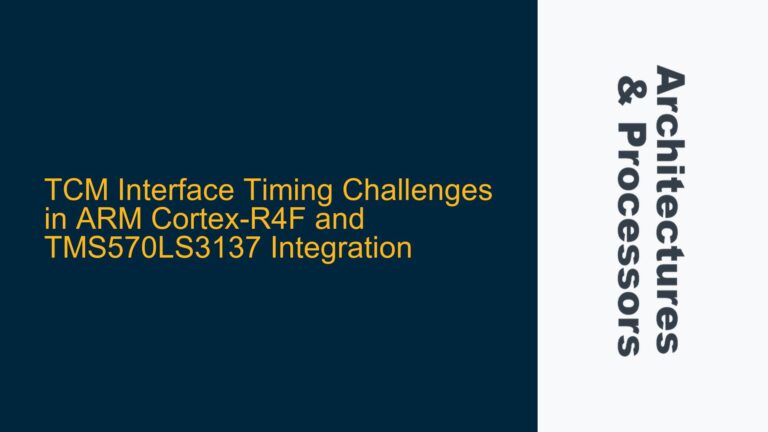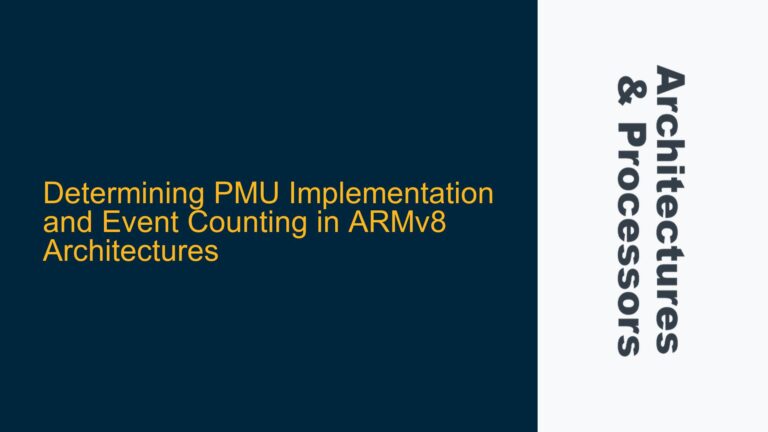ARM Cortex-A53 ACP Burst Size Constraints and DMA Behavior
The ARM Cortex-A53 processor, part of the ARMv8-A architecture, is widely used in embedded systems due to its balance of performance and power efficiency. One of its key features is the Accelerator Coherency Port (ACP), which allows external devices, such as DMA controllers, to access the processor’s cache coherently. However, the ACP has specific burst size constraints that can impact DMA transfers. According to the Cortex-A53 Technical Reference Manual (TRM), the ACP supports burst sizes of 16 bytes and 64 bytes. This limitation raises questions about how DMA transfers should be configured and managed when interfacing with the ACP.
The core issue revolves around whether the DMA controller must adhere strictly to the ACP’s burst size limitations or if it can handle larger transfers by automatically breaking them down into multiple ACP-compliant bursts. In the context of the Cortex-A53, the DMA controller is typically designed to handle larger transfer sizes, but the ACP’s burst size constraints introduce a layer of complexity. Specifically, if the DMA controller is configured to transfer data in chunks larger than 64 bytes, it must internally manage the division of these transfers into 16-byte or 64-byte bursts that comply with the ACP’s requirements.
The confusion arises from the interaction between the DMA controller and the ACP. While the DMA controller may be capable of handling larger transfers, the ACP’s burst size limitations mean that the DMA controller must either be explicitly programmed to handle these constraints or rely on hardware logic to manage the breakdown of larger transfers. This interaction is critical for ensuring efficient data transfer and avoiding performance bottlenecks.
Hardware Design Limitations and Firmware Overhead in DMA-ACP Interaction
The primary cause of the issue lies in the hardware design of the DMA controller and its interaction with the ACP. In some implementations, the DMA controller may not automatically handle the breakdown of larger transfers into ACP-compliant bursts. Instead, the firmware must manually reconfigure the DMA controller for each 64-byte chunk of data, leading to significant overhead and reduced performance. This design limitation can stem from several factors:
-
DMA Controller Design: The DMA controller may lack the necessary logic to automatically divide larger transfers into ACP-compliant bursts. This could be due to cost constraints, design complexity, or a focus on simplicity in the hardware implementation. As a result, the firmware must handle the division of transfers, which increases software complexity and reduces efficiency.
-
ACP Burst Size Constraints: The ACP’s burst size limitations are inherent to its design and cannot be bypassed. These constraints are in place to ensure efficient use of the ACP’s bandwidth and to maintain cache coherency. However, they require careful management of data transfers to avoid performance degradation.
-
Firmware-DMA Interaction: In some systems, the firmware must explicitly manage the DMA controller’s source and destination addresses for each burst. This requirement can arise from the DMA controller’s inability to automatically increment addresses or handle multi-burst transfers. As a result, the firmware must intervene after each 64-byte transfer, leading to increased latency and reduced throughput.
-
Alignment Issues: Misalignment of source and destination addresses can exacerbate the problem. If the data being transferred is not aligned to the ACP’s burst size boundaries, the DMA controller may need to perform additional operations to handle partial bursts, further increasing overhead.
These factors collectively contribute to the challenges of using DMA with the ACP on the Cortex-A53. Addressing these issues requires a combination of hardware and firmware optimizations, as well as a thorough understanding of the ACP’s behavior and the DMA controller’s capabilities.
Optimizing DMA Transfers for ACP Compliance and Performance
To address the challenges of DMA transfers through the ACP on the Cortex-A53, several steps can be taken to optimize performance and ensure compliance with the ACP’s burst size constraints. These steps involve both hardware and firmware-level optimizations, as well as careful configuration of the DMA controller and ACP.
Hardware-Level Optimizations
-
DMA Controller Enhancements: If possible, the DMA controller should be designed or configured to automatically handle the breakdown of larger transfers into ACP-compliant bursts. This can be achieved by incorporating logic that divides transfers into 16-byte or 64-byte chunks and manages the associated address increments. Such enhancements reduce the need for firmware intervention and improve overall performance.
-
Address Alignment: Ensuring that source and destination addresses are aligned to the ACP’s burst size boundaries can significantly improve performance. Misaligned addresses can lead to partial bursts, which require additional handling and reduce efficiency. By aligning addresses, the DMA controller can maximize the use of the ACP’s bandwidth and minimize overhead.
-
Burst Size Configuration: The DMA controller should be configured to use the largest possible burst size supported by the ACP (64 bytes) to minimize the number of bursts required for a given transfer. This reduces the frequency of firmware interventions and improves throughput.
Firmware-Level Optimizations
-
Burst Management: If the DMA controller cannot automatically handle the breakdown of larger transfers, the firmware must manage this process. This involves configuring the DMA controller for each 64-byte burst, updating the source and destination addresses, and restarting the transfer as needed. While this approach increases firmware complexity, it ensures compliance with the ACP’s burst size constraints.
-
Data Synchronization: Proper use of data synchronization barriers (DSB) and cache management instructions is critical when using the ACP. These instructions ensure that data is properly synchronized between the DMA controller and the processor’s cache, preventing coherency issues and ensuring data integrity.
-
Performance Monitoring: Monitoring the performance of DMA transfers can help identify bottlenecks and areas for improvement. Tools such as performance counters and trace analyzers can provide insights into the efficiency of DMA transfers and highlight opportunities for optimization.
Example Implementation
To illustrate these optimizations, consider a scenario where a 256-byte data transfer is required. The following steps outline how this transfer can be optimized for ACP compliance:
-
Configure DMA Controller: Set the DMA controller to transfer 64-byte chunks, ensuring that the source and destination addresses are aligned to 64-byte boundaries.
-
Initialize Transfer: Start the DMA transfer for the first 64-byte chunk. Once the transfer is complete, the DMA controller should generate an interrupt or signal to indicate that the next chunk can be processed.
-
Update Addresses: In the interrupt service routine (ISR), update the source and destination addresses for the next 64-byte chunk and restart the DMA transfer.
-
Repeat Process: Repeat the process until the entire 256-byte transfer is complete. Ensure that proper synchronization and cache management instructions are used to maintain data integrity.
By following these steps, the firmware can efficiently manage DMA transfers through the ACP while complying with its burst size constraints. This approach minimizes overhead and ensures optimal performance.
Advanced Techniques
For systems requiring higher performance, advanced techniques such as scatter-gather DMA and double buffering can be employed. Scatter-gather DMA allows the DMA controller to handle non-contiguous memory regions, reducing the need for firmware intervention. Double buffering involves using two buffers to overlap data transfer and processing, further improving throughput.
Additionally, leveraging the Cortex-A53’s NEON vector processing capabilities can provide an alternative to DMA for certain types of data transfers. NEON can handle 16-byte vector loads and stores, which may be more efficient than DMA for small, frequent transfers.
Conclusion
The interaction between the DMA controller and the ACP on the ARM Cortex-A53 presents unique challenges due to the ACP’s burst size constraints. By understanding these constraints and implementing appropriate hardware and firmware optimizations, it is possible to achieve efficient and reliable data transfers. Key strategies include enhancing the DMA controller’s capabilities, ensuring proper address alignment, and carefully managing burst transfers in firmware. Advanced techniques such as scatter-gather DMA and NEON vector processing can further improve performance in demanding applications. With these optimizations, the Cortex-A53 can deliver the high-performance data transfer capabilities required for modern embedded systems.

